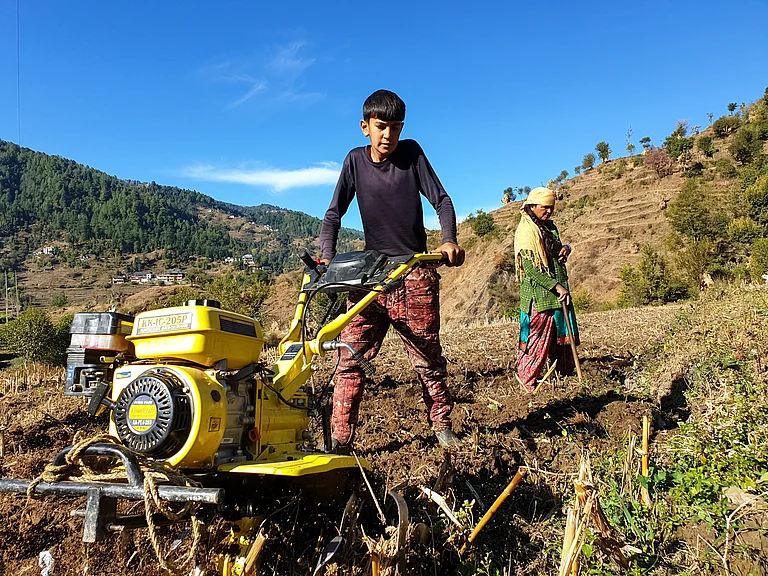Last night, Shimla's gentle rain was a soothing retreat as I drifted into a deep sleep. The raindrops tapped rhythmically on the windowpane like soft serenade. It was sharply in contrast with the torrential downpours of last year's monsoon. Those rains were unrelenting, brought down trees which came crashing down onto homes, roads, and hillsides. The buildings and houses crumbled, structures collapsed like a house of cards.
The memories of last year’s thunderstorm and crackling lightning are still vivid and frightening. It looked as if nature itself was exacting revenge for the violations it had endured. The deafening roar of the clouds and intermittent flashes of lightning felt like nature’s way of protesting against the harm humans inflicted upon it.
In this backdrop, the monsoon this time brought a different story to British era hill stations, its increasing population and altered weather cycle—rains, snowfall and rising temperature.
Lord Hanuman, ever the vigilant guardian atop Jakhu Hill, appeared to offer a respite from the unforeseen miseries linked to mountain ecology. The gentle rain that fell this time brought a sense of hope to the town, as if nature voluntarily granted respite amidst ongoing struggle for harmony with nature.
But as I stepped out to my routine morning walk through US Club to Daizy Bank estate and Forest road (Shimla’s walking paradise) amidst majestic cedars, my thoughts wandered to a different kind of resilience.
Did anyone notice how Shimla’s water heritage had awakened in the night? The ravines cascading down from Jakhu Hill-- a crucial repository of groundwater had sprung back to life. The old Shimla natives fondly remember the days when water flowed abundantly from these sources and was seen as a lifeline to the town. These ravines with their deep roots in the past, seemed to breathe with renewed vigor, whispering tales of times when pure, clean water was plentiful.
Justice Rajeev Sharma, Shimla-born lawyer, who rose to the highest post of acting Chief Justice, often spoke of his nostalgia for Shimla’s water heritage. Other day, I heard him speaking at a well attended formal dialogue on Climate change and stake-holders’ meet, organised by Friedrich-Ebert-Stiftung (FES), SPROUTS— an Indian Environmental organisation and state’s Forest department jointly.
The retired judge—who delivered several landmark judgments on saving Shimla’s green cover against haphazard constructions and dangers they pose to 30,000 population designed town, vividly recalled how old wisdom to living with nature in harmony passed down through generations.
“Our parents had warned us against the closure of the ancient natural water sources known as ‘bawdis’ of Shimla. They had fear that we might disrupt the delicate balance or get drowned by stepping into them. These ‘bawdis’ were more than just reservoirs; they were integral to the town’s water needs throughout the year.
One of these –nick named ‘Chudail Bawdi’ –a haunted place ,on Sanjauli- Chota Shimla road, next to St.Bede’s college, still exists though quite an abandoned state. Other next to Combermere bridge has got erased by massive buildings and urban invasion. Same is the fate of Shimla’s ever-flowing ravines – the nullahs encroached, blocked and done to death by unmindful constructions.
Jakhu’s snow-galleries, the natural reservoirs of winter snow, preserved for storing snow all through the year used to keep the natural sources recharged, sustain the ravines heritage of hill town.
Tikender Singh Panwar, the former Deputy Mayor of Shimla and a dedicated conservationist, speaking at the event highlighted how the British utilized Shimla judiciously during the summers, retreating from the hills in winter. This practice wasn't merely due to the cold or snow, but rather a recognition that prolonged stays would strain the tranquil hill station and lead to the over-exploitation of its natural resources. The population size was capped at 30,000 for Shimla, he underlined a historic fact.
But, the rain last night was more than just a meteorological event. It was a reminder of Shimla’s enduring relationship with water—a relationship steeped in history and reverence. The rain brought with it not only a sense of renewal but also a gentle nudge to remember and respect the town's water heritage.
In the silence that followed, as the rain subsided and the clouds drifted away, Shimla lived on with hope in the changing environs. The old sources, the once-forgotten bawdies are testament to the town’s resilience, whispering stories of survival and sustainability to those who would listen.
We hold in our hearts the memory of the 20 lives lost at Shiv Bawdi during the tragic landslide last August, which devastatingly swept away the temple building. This disaster followed torrential rains in Shimla,and several parts of the state. Experts have indicated that the water reservoirs beneath the majestic Viceregal Lodge, home to the Indian Institute of Advanced Studies (IIAS), had burst, leading to the heartbreaking loss of entire families. Among those affected was a family that lost seven members, including three young girls.
As I returned home after my rewarding 11,000-step walk, I could almost hear Shimla inviting me, “Come, let’s walk hand in hand, and breathing together in harmony and raise voice against environmental vandalism, saving glory of hill station, its trees and water heritage ’


























